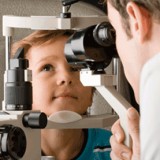Importance of Kids’ Vision Screening
Kids’ vision screening tests may help to catch vision problems early on, and may also be helpful in spotting more severe medical conditions. Vision problems may impact childhood development, perception, and education, so it is important to identify vision problems and take corrective action. Medical conditions such as pediatric retinoblastoma may be life-threatening, and catching these types of severe conditions at a very early age drastically improves the chances for survival and retention of vision.
Kids’ Vision Screening Tests
Kids typically receive the first rudimentary vision screening at the well baby exam, which is usually scheduled about three to five days after the baby is discharged from the hospital. Well baby exams continue to be scheduled approximately every two to four months for a year. During these exams, the baby’s eyes are generally checked for dilation response to light and eye movements, as well as eye appearance that may indicate infection. Children should receive vision screenings at regular check-ups, and should receive a very thorough vision check around the age of three or four prior to starting preschool.
Screening tests which may be used when examining children include:
- Photoscreening, using photography to detect eye abnormalities
- Cover testing, which is used to detect shifts in eye movements when following a target
- Light reflex testing, which is used to detect abnormalities in the eyes by the way light from a penlight is reflected
- Random dot steropsis, which uses patterns of dots and 3D glasses to test how well eyes work together
- Snellen charts, which use differently sized letters to test overall vision
- Depth perception tests
Vision Complications and Conditions
While severe conditions are relatively rare in children, minor conditions that affect vision are present in roughly five to ten percent of children under the age of five, and nearly one quarter of school aged children. These conditions may worsen and cause partial or total loss of vision if not corrected quickly enough, in some cases. Rare conditions which are present may also be caught during vision screening tests, so it is important to make sure that children receive vision screening even if there are no obvious symptoms of vision problems.
Common eye conditions which may be detected in children include:
- Myopia, or near sightedness
- Hyperopia, or far sightedness
- Astigmatism
- Amblyopia, or lazy eye
- Strabismus, or wandering eye
Corrective Actions
For eyesight problems such as astigmatism, myopia, or hyperopia, glasses or contacts may be prescribed to help correct vision. In cases of amblyopia, patching may be required to strengthen the weaker eye. In cases of infection, abnormalities, or more severe conditions, antibiotics or surgeries may be helpful. Beginning treatment early on can help to prevent vision loss and even preserve life in the case of severe conditions such as pediatric retinoblastoma.
Sources:
http://www.geteyesmart.org/eyesmart/eye-health-news/early-vision-screening-for-children.cfm
http://healthfinder.gov/HealthTopics/Category/doctor-visits/screening-tests/get-your-childs-vision-checked
http://www.uniteforsight.org/eye-health-teachers/importance-vision-screening-for-children

















